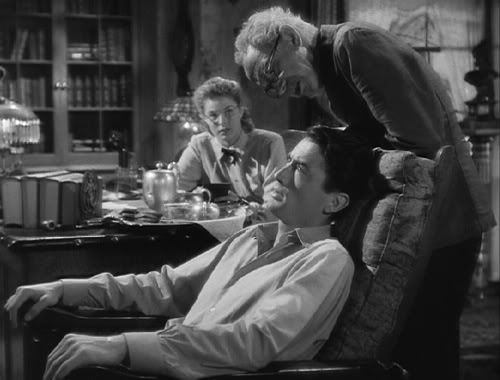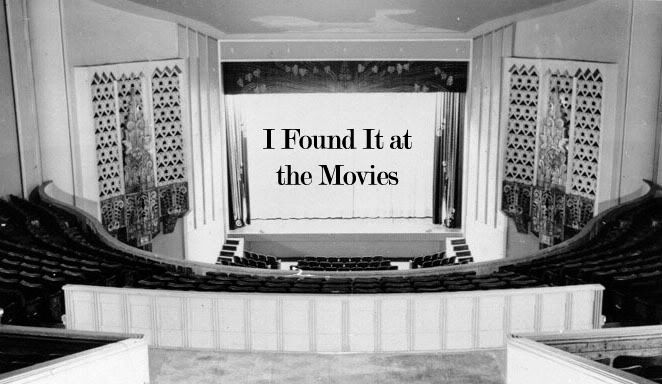
Hitchcock and Authorship: Spellbound
If there were ever a single figure for Alfred Hitchcock who undermined his claims to the authorship of any of his films, it would be David O. Selznick. Hitchcock’s first producer in the United States, Selznick’s sensibilities were in stark contrast to those of Hitchcock. Hitchcock dismissed the first American film he directed, Rebecca, as “not a Hitchcock picture,” implicitly pinning its failings on Selznick’s “theory that people who had read the novel [by Daphne du Maurier] would have been very upset if it had been changed on the screen.”(1) Indeed, such adherence to the source material flew in the face of Hitchcock’s normal working methods, which usually gutted the novel/story/play upon which the script was based. Moreover, his dismissal of the film as not his own speaks not only to his acknowledgment of Selznick’s interference, but also to how strongly Hitchcock was aware of himself as the author of his films. It is this notion of authorship that Hitchcock often used as a barometer for whether or not he liked his own work. By extension, the question “what is a Hitchcock film?” becomes central to Hitchcock studies, and from such an auteurist viewpoint, can structure the worth of certain pictures as more important than others.
Another example of conflict between authors will be examined forthwith, using the second film Selznick produced for Hitchcock, Spellbound. Selznick’s voice is more difficult to conclusively infer compared to Rebecca; Paula Cohen points to Selznick losing power in Hollywood throughout the 1940's, thus making it more difficult for him to control elements of production the way he used to.(2) The “Selznick touch” is more blatant in the film, according to Cohen; this will be addressed more fully later. What is the prime concern of this paper is Hitchcock’s signature, and whether or not it still makes its presence felt despite external creative sources (i.e. Selznick).
Firstly–and perhaps most importantly–the theme of psychoanalysis is presented more explicitly in the film than anywhere else in Hitchcock’s oeuvre. Scholarship has often come back to psychoanalysis to read Hitchcock’s films. None of the other films, however, have their narratives based upon the concept so blatantly as Spellbound has. According to Cohen, this is Selznick’s doing, who had been in analysis for some years.(3) But aside from this, Cohen states that Selznick didn’t have any direct involvement with the film until late into editing. Thus, we are left with Hitchcock having the ability to exercise his creative voice solely within the project.
Cohen’s text also asserts that not only did Hitchcock regain his voice in the film, but that Selznick had implicitly become part of that voice. “[Selznick’s] contribution [to Hitchcock’s development as a filmmaker] can be summarized as follows: he steered Hitchcock toward strong ‘domestic’ narratives (the du Maurier novel; the psychoanalytic theme); he alerted Hitchcock to the challenge of novelistic character...and he encouraged Hitchcock in a more creative use of the female performer. Spellbound can be read as something of an allegory of the painful, but ultimately fruitful, effects of Selznick’s influence.”(4) Is this assertion relevant? Is it even plausible? Female protagonists certainly didn’t play so central a role in the British films (despite the characters of Alice in Blackmail and Iris in The Lady Vanishes, for example). Are Joan Fontaine in Rebecca, young Charlie in Shadow of a Doubt, Alicia in Notorious, and the blondes of the 1950's films the products of Selznick and Hitchcock’s cross-pollination? Spellbound may offer some answers.
Let us return to the idea of psychoanalysis. Hitchcock scholarship has often come back to psychoanalytic theory to explain sexual (and, subsequently, narrative) dynamics of the primary characters in Hitchcock’s films, but only Spellbound literally takes psychoanalysis as the direct agent for its narrative. What does such a use of psychoanalysis do? To begin with, it foregrounds the need to decipher past experience as a means of purging current states of emotional crisis. John Ballantine’s amnesia–quite bluntly revealed during the film’s exposition–is rooted in childhood trauma, and he will only be cured and cleared of murder charges when he uncovers this trauma through analysis.
Lesley Brill sees this method as a way in which the romantic tradition of purging the past to heal the present continues, albeit in modern scientific terms. Brill similarly sees the psychoanalytic project to reconstitute identity analogous to the romantic quest for similar ends. In Brill’s mind, the distinctly romantic elements of this quest undercut the scientific notions of psychoanalysis. “Not only does Hitchcock radically condense the process of psychiatric self-discovery, but he explicitly attacks parts of its scientific framework, notably its emphasis on an ultimate professional impersonality and its dependence on deductive procedures.”(5) Indeed, one can find textual evidence of this within the film, when both Dr. Fleurot and Ballantine (masquerading as Dr. Edwardes) remark to Dr. Petersen about the need for impulse, for feeling, and not complete reliance on cold data.
Does this notion of psychoanalysis as romantic quest hold up? I’m not so sure. Indeed, Brill goes to great lengths to say that due to the film’s links with romantic archetypes, realism and plausibility no longer are factors when analyzing the film’s structure; in fact, the point is quite the opposite. Hitchcock’s use, according to Brill, of “such intrusive artificiality implies that works of art reveal essential significance by condensing and cutting through the haze that makes up most of daily experience.”(6) This is a viable statement for many of Hitchcock’s films, including ones which Brill classifies as “ironic” rather than “romantic;” but, like Brill’s thesis as a whole, it is difficult to ascribe this quality to all of Hitchcock’s work, namely, Spellbound.
One of the things that Brill says is incorrect to criticize Spellbound for is its being “‘talky’ or ‘theatrical.’”(7) The film has these traits, but they are used to turn the story into an archetypal romance, a modern version of a classic tale of love conquering demons, and identity restoring itself through the purging of those demons. Therefore, the film’s “talkiness” and “theatricality” are meant to elucidate meaning, rather than hinder it. This concept, however, is not as strongly present as Brill would like to think.
The “talkiness” of the film is a most intriguing tool of Hitchcock’s. He was always one to flout the greatness of silent cinema, the idea of making narrative “purely cinematic.” Indeed, his best films use dialogue only sparingly, for the very purpose of telling a story through visual means.(8) Yet, Spellbound is a dialogue-choked film, with characters constantly talking in order to dissect the hidden meanings of their behaviors. Paula Cohen reminds us that psychoanalysis was dubbed the “talking cure” when it was developed in the early 20th Century. “Talk, as Freud used it, was a therapeutic method by which unconscious information could be brought to the surface and made available for interpretation.”(9) It is as if Hitchcock was using the continuous flow of dialogue to illustrate the very techniques of psychoanalysis as part of the style.
This “talking cure” style, however, only further problematizes the film. Hitchcock uses the dialogue almost heavy-handedly, doling out explanations as if they were deadweight. No attempt is made to express the emotional intensity of the narrative through only visual means. The most recognizable visual sequence of the film–the Dali-designed dream sequence–is narrated by Ballantine, and continually interrupted by Petersen and Dr. Brulov. If one compares a similar dream Hitchcock constructed in Vertigo (where Scotty dreams of Elster and Carlotta standing next to him, and of him falling into Carlotta’s grave), then one sees that Dali’s images are being subverted by an obsession to explain them. Indeed, Cohen senses this as well within the sequence, saying that “the blatant artificiality of the imagery brings its metaphoric function into relief but jars with the narrative thrust of the film as a whole and with the narrative that accompanies the sequence in particular.”(10)
Cohen’s argument begins to contradict itself in a certain manner over this point. She speaks to the “fated...clash” of narrative and pictorial aspects within the film, each of which she distinctly assigns to Selznick (narrative) and to Hitchcock (visual).(11) Yet, as previously mentioned, Cohen believes that Selznick informed Hitchcock’s narrative thinking for the better, allowing him to develop more psychologically complex characters, specifically female ones. If the dream sequence can be used as a metonym for the rest of the film (and I believe it can, in certain respects), then how are Selznick and Hitchcock’s voices working well together? It doesn’t seem as though they are.
Consider Ballantine’s final revelation that allows him to purge himself of his amnesia and guilt complex. The sequence begins normally enough, with Petersen and Ballantine skiing down a mountain, in the hopes that it will trigger Ballantine’s memory. The cliff makes him remember the accidental killing of his brother, handled in an 8-second flashback that Ballantine narrates. Hitchcock would normally have allowed that flashback to run its course, in terms of its need to serve the story. It is a revelatory moment, one to which Hitchcock would normally devote a greater amount of time. Ballantine also delivers a superfluous voice-over narration (“It was something from my childhood! I killed my brother!”) in addition to the imagery. This seems completely incongruous to Hitchcock’s normal style. When talking to Francois Truffaut about North by Northwest, Hitchcock explicated the scene between Thornhill and the Professor at the airport: “It wasn’t necessary for that to be heard because the public already had the information.”(12) In Spellbound, Hitchcock is making redundant the very things within the narrative that one would think would be most powerful. Nothing feels like Hitchcock in these sequences.
Moreover, the visual quality of the film is more reminiscent of Rebecca than it is of Hitchcock’s other films. One sees very dynamic lighting contrasts, casting strong shadows across the walls and faces of the characters. While this very textured style served the purpose of Rebecca’s constant presence in Manderley, here it only bolsters the notion of psychological duplicity, a point already made plain by the shower of dialogue. What is interesting about the use of textured shadows in these films is that they aren’t seen elsewhere in his body of work. Paula Cohen sees this imbuing of Hitchcock with Selznick’s style as a positive thing. If one, however, analyzes these qualities in Spellbound within the context of Hitchcock’s other work, the more one realizes that the stylistic tendencies which produce Hitchcock’s primary concerns (moral ambiguity, ambivalence toward femininity, the fragility of the order of modern life) become undermined by Selznickian melodrama. “FT: There are some very beautiful scenes in the picture. For instance, the one showing the seven doors opening after the kiss, and even the first meeting between Gregory Peck and Ingrid Bergman; that was so clearly love at first sight. AH: Unfortunately, the violins begin to play just then. That was terrible!”(13)
Let us consider the gender dynamic of the film. On the one hand, Hitchcock’s handling of gender roles is quite intriguing, given their reversal (the female Petersen as the clinical doctor, the male Ballantine as the hysterical patient). However, characters consistently refer to Petersen’s displacement as a doctor. As previously mentioned, Fleurot speaks of her lack of warmth; she has “no intuition” (a stereotypical “frigid woman” trait). When she and Ballantine are out walking together, he consistently brings up how wrong she is to disregard love. Later, when she and Brulov argue about Ballantine, he criticizes her femininity: “the mind of a woman in love is operating on the lowest level of the intellect.” Earlier, he says that “women in love make the best psychoanalysts ’till they fall in love; then they make the best patients.” One can infer from these exchanges that Petersen’s only redemption is to become a “real woman”: to embrace romantic love, and to unconditionally accept her lover’s faults in order to help him. Nowhere in the film does this get subverted by Hitchcock’s usual ambivalence toward femininity. Compared to films like Notorious or The Birds–where Alicia and Melanie are neither glorified nor condemned for their “pure” and “impure” characteristics–Petersen very simply gives up her independence in order to reaffirm the patriarchy. The film condones this. There is no ambiguity to the moral codes under which Petersen and Ballantine operate. By “curing” themselves with “talk,” there is no longer any deeper meaning or subtext from which we can extricate motivations or notions of characterization.
If it weren’t for Hitchcock’s open dislike for the film, this last point could explain an incredibly clever thing Hitchcock has done with Spellbound. Once the notions of redemption have been identified and achieved through the narrative dialogue, the depth of Petersen and Ballantine’s characterizations are negated. The meanings of their conditions–and thus their lives–have been easily explored and explained, which ties to how loosely Hitchcock used hard psychoanalytic theory (Cohen refers to “psychoanalytic subject matter” in the film as “highly simplified, even bowdlerized”[14]). The lack of depth in the protagonists, especially in comparison to Hitchcock’s greatest films (and the fact that psychoanalysis has always been put upon him, rather than he accepting it willingly), could point to Spellbound being a parodic work, a deliberate subversion of psychoanalysis through the very use of it on levels of form and of content. By making the film heavy-handed and unambiguous, Hitchcock could be illuminating his disdain for such practice in not only film, but in the world. One could see Spellbound as the ultimate critique of psychoanalysis by using it against itself. But Hitchcock claimed to Truffaut that once Selznick gave him the idea about doing a film on psychoanalysis, he supported it (“I wanted to do something more sensible, to turn out the first picture on psychoanalysis”[15]). It would appear that in terms of Hitchcock being “[reluctant] to fantasize” and “[trying] to use a logical approach to the man’s adventure,”(16) Paula Cohen could be correct: Selznick had permeated Hitchcock’s working methods. Where the argument weakens is in the notion that such methods flourished once Hitchcock became his own producer. Spellbound ultimately seems more like a Selznick-dominated misfire than a “Hitchcock picture.”
Notes
1. Francois Truffaut, Hitchcock, with Helen G. Scott, New York: Simon and Schuster, 1983, pp. 127 & 129.
2. Paula Marantz Cohen, Alfred Hitchcock: The Legacy of Victorianism, Lexington, KY: University Press of Kentucky, 1995, p. 53.
3. ibid. p. 54.
4. ibid. p. 55.
5. Lesley Brill, The Hitchcock Romance: Love and Irony in Hitchcock’s Films, Princeton, NJ: Princeton University Press, 1988, p. 240.
6. ibid. p. 281.
7. ibid. p. 281.
8. Truffaut, p. 222.
9. Cohen, p. 56.
10. ibid. p. 60.
11. ibid. pp. 55-6.
12. Truffaut, p. 250. [italics mine]
13. ibid. p. 165.
14. Cohen, p. 56.
15. Truffaut, p. 163.
16. ibid. p. 165.


4 comments:
Clearly you don't understand the significance of the unpublished work. One must keep a few things unpublished to satisfy the literary archeologist who will need to stumble upon these things while searching through the papers of one of your former jilted lovers who pined away to an early demise because she couln't make you happy. The discovery will be debated for years in academia as to how it fits into your body of work, e.g. your "blue " period, post modern expressionism or your crankin' 'em out to make a buck period. I'm just sayin'.........
Have a nice day
Love,
Dad
He's right, you know.
Right about what, Alfred?
Great Post ! Sounds like you have great interest in movies. LOve to hear more from you side..I also love movies and i have good collection of it..
Post a Comment